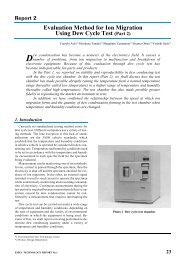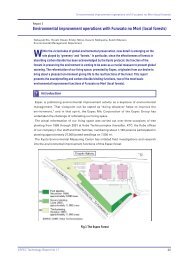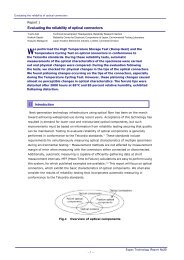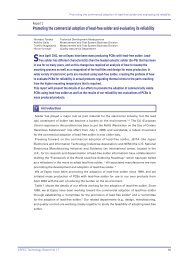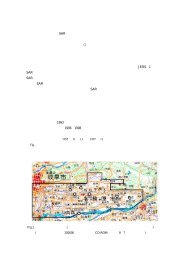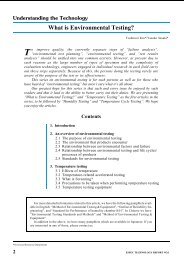Measuring conductivity of proton conductive membranes in the ...
Measuring conductivity of proton conductive membranes in the ...
Measuring conductivity of proton conductive membranes in the ...
Create successful ePaper yourself
Turn your PDF publications into a flip-book with our unique Google optimized e-Paper software.
<strong>Measur<strong>in</strong>g</strong> <strong>conductivity</strong> <strong>of</strong> <strong>proton</strong> <strong>conductive</strong> <strong>membranes</strong> <strong>in</strong> <strong>the</strong> direction <strong>of</strong> thickness<br />
Report 2<br />
<strong>Measur<strong>in</strong>g</strong> <strong>conductivity</strong> <strong>of</strong> <strong>proton</strong> <strong>conductive</strong> <strong>membranes</strong> <strong>in</strong> <strong>the</strong><br />
direction <strong>of</strong> thickness<br />
Shuhua Ma, Akiko Kuse Technical Development Headquarters, Espec Corp.<br />
Zyun Siroma, Kazuaki Yasuda National Institute <strong>of</strong> Advanced Industrial Science and Technology (AIST)<br />
P<br />
roton <strong>conductive</strong> membrane is generally evaluated by measur<strong>in</strong>g its<br />
<strong>conductivity</strong> along <strong>the</strong> planes <strong>of</strong> <strong>the</strong> membrane. However, <strong>in</strong> view <strong>of</strong> <strong>the</strong><br />
possibility <strong>of</strong> this membrane exhibit<strong>in</strong>g anisotropy <strong>in</strong> <strong>the</strong> direction <strong>of</strong><br />
membrane thickness compared to measur<strong>in</strong>g along <strong>the</strong> longitud<strong>in</strong>al and<br />
transversal planes, <strong>the</strong> need to measure its <strong>conductivity</strong> <strong>in</strong> <strong>the</strong> direction <strong>of</strong><br />
thickness has recently been receiv<strong>in</strong>g greater attention. The research work<br />
for this report is aimed at f<strong>in</strong>d<strong>in</strong>g a way to stably and precisely measure <strong>the</strong><br />
<strong>conductivity</strong> <strong>of</strong> a Nafion ®1) membrane <strong>in</strong> <strong>the</strong> direction <strong>of</strong> thickness.<br />
Measurements can be conducted with ei<strong>the</strong>r 2- or 4-probe methods, but<br />
measur<strong>in</strong>g with 2 probes is much easier than with 4, and this method yields<br />
more stable results as fewer <strong>in</strong>consistencies occur with multiple specimens.<br />
This report presents <strong>the</strong> results with <strong>the</strong> 2-probe method for membrane<br />
<strong>conductivity</strong> measurements with an emphasis on <strong>the</strong> effect <strong>of</strong> <strong>in</strong>terface<br />
complexity between membrane and electrodes and <strong>the</strong> feasibility <strong>of</strong> us<strong>in</strong>g<br />
this method for measurements.<br />
1<br />
Polymer electrolyte membrane fuel cells (PEFCs) are promis<strong>in</strong>g energy systems for use<br />
as automotive power supplies and for stationary as well as portable applications, due to<br />
<strong>the</strong>ir low operat<strong>in</strong>g temperature, high energy density, and acceptable levels <strong>of</strong><br />
m<strong>in</strong>iaturization. S<strong>in</strong>ce it is one <strong>of</strong> <strong>the</strong> most important criteria, <strong>proton</strong> <strong>conductivity</strong> is<br />
always used to evaluate <strong>the</strong> practicability <strong>of</strong> newly-developed <strong>membranes</strong> as well as <strong>the</strong><br />
cell performance <strong>of</strong> <strong>the</strong> perfluorosulfonic acid (PFSA) polymer membrane <strong>of</strong>ten used with<br />
PEFC. 2)<br />
Introduction<br />
Compared to <strong>the</strong> <strong>conductivity</strong> <strong>in</strong> <strong>the</strong> direction <strong>of</strong> thickness, <strong>the</strong> resistance measured <strong>in</strong><br />
along <strong>the</strong> plane reaches as high as 1000Ω, which features a large cell constant *1 (L/A <strong>in</strong><br />
σ=L/(R·A)). The four-probe method *2 yields narrower data dispersion and smaller<br />
relative errors, thus this method is commonly used to measure <strong>the</strong> <strong>proton</strong> <strong>conductivity</strong> <strong>of</strong><br />
<strong>the</strong> PFSA membrane *3 along <strong>the</strong> plane.<br />
- 12 -<br />
Espec Technology Report No20
<strong>Measur<strong>in</strong>g</strong> <strong>conductivity</strong> <strong>of</strong> <strong>proton</strong> <strong>conductive</strong> <strong>membranes</strong> <strong>in</strong> <strong>the</strong> direction <strong>of</strong> thickness<br />
However, it is highly likely that treatments <strong>the</strong> membrane undergoes <strong>in</strong> <strong>the</strong><br />
manufactur<strong>in</strong>g and process<strong>in</strong>g processes, such as stretch<strong>in</strong>g and hot-press, will change<br />
not only its crystall<strong>in</strong>e structure and dimensional stability <strong>in</strong> <strong>the</strong> longitud<strong>in</strong>al, transverse,<br />
and thickness directions but also exert some <strong>in</strong>fluence on its <strong>proton</strong> <strong>conductivity</strong>. There<br />
is a high probability <strong>of</strong> anisotropy3) <strong>in</strong> <strong>the</strong> <strong>proton</strong> <strong>conductivity</strong> <strong>of</strong> <strong>the</strong> membrane. On <strong>the</strong><br />
o<strong>the</strong>r hand, PFSA <strong>membranes</strong> are be<strong>in</strong>g used <strong>in</strong> <strong>the</strong> direction <strong>of</strong> thickness for <strong>the</strong> solid<br />
polymer electrolyte fuel cells, and an anisotropically <strong>conductive</strong> membrane that was<br />
newly-developed must also be evaluated <strong>in</strong> various directions. Therefore, a reliable<br />
measur<strong>in</strong>g technique with high stability, reproducibility and accuracy is required to<br />
evaluate <strong>proton</strong> <strong>conductivity</strong> <strong>in</strong> <strong>the</strong> direction <strong>of</strong> thickness <strong>of</strong> <strong>the</strong> membrane. The research<br />
for this report focuses on develop<strong>in</strong>g a stable and precise method <strong>of</strong> measur<strong>in</strong>g<br />
<strong>conductivity</strong> <strong>in</strong> <strong>the</strong> direction <strong>of</strong> thickness for <strong>the</strong> <strong>proton</strong>-<strong>conductive</strong> polymer electrolyte<br />
membrane. 4)<br />
Measurements <strong>in</strong> <strong>the</strong> direction <strong>of</strong> thickness can be conducted with 2-probe *4 and<br />
4-probe methods, but measur<strong>in</strong>g with two probes is much easier than with four, and<br />
results are more stable as <strong>the</strong>re are fewer <strong>in</strong>consistencies with multiple specimens. This<br />
report presents <strong>the</strong> results obta<strong>in</strong>ed us<strong>in</strong>g <strong>the</strong> 2-probe method for <strong>conductivity</strong><br />
measurements <strong>of</strong> ion exchange <strong>membranes</strong>.<br />
2<br />
Experimental method<br />
2-1 Equipment and materials<br />
Table 1 lists <strong>the</strong> equipment and materials used <strong>in</strong> this research.<br />
Table 1 Equipment and materials<br />
Equipment/materials Manufacturer<br />
Impedance ga<strong>in</strong>/phase<br />
analyzer<br />
- 13 -<br />
Model/registered<br />
product name<br />
Solartron Instruments SI 1260<br />
Electrochemical <strong>in</strong>terface Solartron Instruments SI 1287<br />
Temperature & humidity<br />
chamber<br />
Ion exchange membrane<br />
ESPEC Corporation PL-1KPH<br />
E. I. du Pont de Nemours<br />
and Company<br />
Nafion ® 117<br />
Espec Technology Report No20
<strong>Measur<strong>in</strong>g</strong> <strong>conductivity</strong> <strong>of</strong> <strong>proton</strong> <strong>conductive</strong> <strong>membranes</strong> <strong>in</strong> <strong>the</strong> direction <strong>of</strong> thickness<br />
2-2 Specimen preparation<br />
MEA specimens were made by hot-press<strong>in</strong>g electrodes to a Nafion ® 117 membrane. In a<br />
prelim<strong>in</strong>ary test, measurements were made with two k<strong>in</strong>ds <strong>of</strong> MEAs. One type <strong>of</strong> MEA<br />
specimen was produced by hot-press<strong>in</strong>g two Pt foil electrodes, coated with Nafion ®<br />
solution on one side each, to a membrane. The o<strong>the</strong>r MEA specimen was produced by<br />
hot-press<strong>in</strong>g two Pt foil electrodes to a membrane without us<strong>in</strong>g <strong>the</strong> Nafion ® coat<strong>in</strong>gs.<br />
Results showed good reproducibility with <strong>the</strong> Nafion ® -coated specimen, <strong>the</strong>refore, <strong>in</strong> this<br />
report specimens were prepared by coat<strong>in</strong>g a Nafion ® solution onto one surface <strong>of</strong> <strong>the</strong><br />
electrodes for voltage impression unless o<strong>the</strong>rwise specified.<br />
For 2-probe measurements <strong>in</strong> <strong>the</strong> direction <strong>of</strong> thickness, specimens were prepared by<br />
hot-press<strong>in</strong>g a Nafion ® membrane sandwiched <strong>in</strong>to electrodes consist<strong>in</strong>g <strong>of</strong> two pieces <strong>of</strong><br />
metal sheets (5 mm x 5 mm x 10 to 20µm) or carbon papers (5 mm x 5 mm x 190µm)<br />
situated opposite each o<strong>the</strong>r. On one face <strong>of</strong> <strong>the</strong> metal sheets, a coat<strong>in</strong>g was applied with<br />
5 µl <strong>of</strong> 5 wt. % Nafion ® dispersion solution <strong>in</strong> lower aliphatic alcohols followed by vacuum<br />
dry<strong>in</strong>g one hour at room temperature. No coat<strong>in</strong>g was used on <strong>the</strong> carbon paper<br />
electrodes. Photo 1 shows <strong>the</strong> configuration <strong>of</strong> <strong>the</strong> membrane/electrode assembly<br />
(MEA *5 ) used <strong>in</strong> this report for <strong>the</strong> 2-probe measurements <strong>in</strong> <strong>the</strong> direction <strong>of</strong> thickness.<br />
The assembly is made <strong>of</strong> plat<strong>in</strong>ized Pt black sheets and Nafion ® 117 membrane.<br />
Photo.1 MEA <strong>of</strong> Pt black/Nafion ® 117 for 2-probe measurements <strong>in</strong><br />
<strong>the</strong> direction <strong>of</strong> thickness<br />
For 4-probe measurements <strong>in</strong> <strong>the</strong> direction <strong>of</strong> thickness, <strong>the</strong> specimens were prepared<br />
by sandwich<strong>in</strong>g and hot-press<strong>in</strong>g plat<strong>in</strong>um wire electrodes between three Nafion ®<br />
<strong>membranes</strong> and <strong>the</strong>n, as with <strong>the</strong> specimens for <strong>the</strong> 2-probe measurements,<br />
hot-press<strong>in</strong>g metal sheets that had been coated with Nafion ® solution and vacuum-dried<br />
onto both outside faces <strong>of</strong> <strong>the</strong> assembly.<br />
- 14 -<br />
Espec Technology Report No20
<strong>Measur<strong>in</strong>g</strong> <strong>conductivity</strong> <strong>of</strong> <strong>proton</strong> <strong>conductive</strong> <strong>membranes</strong> <strong>in</strong> <strong>the</strong> direction <strong>of</strong> thickness<br />
S<strong>in</strong>ce 4-probe measurements <strong>in</strong> <strong>the</strong> surface direction obta<strong>in</strong>ed results with better<br />
reproducibility, <strong>the</strong>se measurements were used as comparison reference aga<strong>in</strong>st <strong>the</strong><br />
measurements <strong>in</strong> <strong>the</strong> direction <strong>of</strong> thickness <strong>of</strong> <strong>the</strong> membrane. The specimens for 4-probe<br />
surface direction measurements were prepared by press-fitt<strong>in</strong>g metal sheets to both<br />
ends <strong>of</strong> <strong>the</strong> Nafion ® membrane and vertically pierc<strong>in</strong>g <strong>in</strong>to <strong>the</strong> membrane near <strong>the</strong> center<br />
with plat<strong>in</strong>um wires.<br />
Fig. 1 (a) and (b) respectively show schematics <strong>of</strong> <strong>the</strong> specimens for <strong>the</strong> 2-probe and<br />
4-probe measurements <strong>in</strong> <strong>the</strong> direction <strong>of</strong> thickness, while (c) shows <strong>the</strong> same for <strong>the</strong><br />
4-probe surface direction measurements.<br />
Fig.1 Sample arrangements for (a) <strong>the</strong> 2-probe method, (b) <strong>the</strong> 4-probe<br />
method <strong>in</strong> <strong>the</strong> direction <strong>of</strong> thickness, and (c) <strong>the</strong> 4-probe method <strong>in</strong><br />
<strong>the</strong> surface direction<br />
2-3 Conductivity Measurements<br />
A specimen fixed to a measur<strong>in</strong>g cell was placed <strong>in</strong>side a temperature and humidity<br />
chamber under constant temperature and humidity (80°C, 30 to 90% rh). AC impedance<br />
measurements were taken us<strong>in</strong>g a computer-controlled Solartron Instruments model<br />
1260 impedance ga<strong>in</strong>/phase analyzer and a computer-controlled 1287 electrochemical<br />
<strong>in</strong>terface, and Cole-Cole (Z’-Z’’) and Bode (log|Z|-log Frequency and <strong>the</strong>ta-log<br />
Frequency) plots were obta<strong>in</strong>ed. The frequency limits <strong>of</strong> <strong>the</strong> s<strong>in</strong>usoidal signals were<br />
typically set between 5 MHz and 0.01 Hz, with an oscillation <strong>of</strong> 10 mV. Assum<strong>in</strong>g a circuit<br />
equivalent to <strong>the</strong> one shown <strong>in</strong> Fig.3, a best-fitt<strong>in</strong>g curve was overlaid onto <strong>the</strong><br />
measurements taken by <strong>the</strong> 2-probe method. Conductivity was calculated from <strong>the</strong><br />
obta<strong>in</strong>ed membrane resistance, Rbulk, us<strong>in</strong>g <strong>the</strong> follow<strong>in</strong>g formula.<br />
…(1)<br />
Where σ is <strong>conductivity</strong> (Scm-1 ), L is membrane thickness (cm), A is electrode area<br />
(cm2 ), and R is resistance (Ω).<br />
- 15 -<br />
Espec Technology Report No20
<strong>Measur<strong>in</strong>g</strong> <strong>conductivity</strong> <strong>of</strong> <strong>proton</strong> <strong>conductive</strong> <strong>membranes</strong> <strong>in</strong> <strong>the</strong> direction <strong>of</strong> thickness<br />
Equipment connection for <strong>the</strong> impedance ga<strong>in</strong>/phase analyzer (IGPA), <strong>the</strong><br />
electrochemical <strong>in</strong>terface (EI) and <strong>the</strong> membrane/electrode assembly (MEA) was shown<br />
<strong>in</strong> Fig. 2 for 2-probe <strong>conductivity</strong> measurements used <strong>in</strong> this report.<br />
3<br />
Fig.2 Connections for impedance measured by <strong>the</strong> 2-probe method, with an<br />
IGPA <strong>in</strong> comb<strong>in</strong>ation with potentiostat/galvanostat (electrochemical<br />
<strong>in</strong>terface) mode.<br />
Results and observations<br />
3-1 Humidity dependency <strong>of</strong> resistance and capacity components <strong>of</strong> impedance<br />
In <strong>the</strong> Cole-Cole plot obta<strong>in</strong>ed from <strong>the</strong> 2-probe measurements, two loops appeared.<br />
They were named loop 1 and loop 2 <strong>in</strong> order <strong>of</strong> descend<strong>in</strong>g frequency and were treated as<br />
RY parallel circuits. The resistance and capacity components obta<strong>in</strong>ed from <strong>the</strong> fit were<br />
R1, R2, Y1 and Y2 (Y is a constant phase element and substituted for <strong>the</strong> equivalent<br />
capacity component <strong>in</strong> <strong>the</strong> fitt<strong>in</strong>g process). Fig. 3 shows a diagram <strong>of</strong> <strong>the</strong> equivalent<br />
circuit.<br />
Fig.3 Equivalent circuit for <strong>the</strong> membrane/electrode <strong>in</strong>terface studied<br />
- 16 -<br />
Espec Technology Report No20
<strong>Measur<strong>in</strong>g</strong> <strong>conductivity</strong> <strong>of</strong> <strong>proton</strong> <strong>conductive</strong> <strong>membranes</strong> <strong>in</strong> <strong>the</strong> direction <strong>of</strong> thickness<br />
Measurements were taken at an ambient temperature <strong>of</strong> 80°C us<strong>in</strong>g 4 types <strong>of</strong><br />
electrodes made <strong>of</strong> gold, plat<strong>in</strong>um, plat<strong>in</strong>um black and carbon paper. Fig. 4 shows <strong>the</strong><br />
humidity dependency <strong>of</strong> Rbulk (membrane resistance), R1, Y1, R2, and Y2 us<strong>in</strong>g <strong>the</strong> various<br />
electrode materials.<br />
As ambient relative humidity dur<strong>in</strong>g measur<strong>in</strong>g <strong>in</strong>creased, Rbulk, R1, and R2 decreased.<br />
This phenomenon <strong>in</strong>dicates that <strong>the</strong> <strong>conductivity</strong> <strong>of</strong> <strong>proton</strong>-<strong>conductive</strong> polymer materials<br />
such as Nafion ® depend on <strong>the</strong>ir water content. In particular, m<strong>in</strong>imum resistance was<br />
obta<strong>in</strong>ed for R1 and R2 when us<strong>in</strong>g <strong>the</strong> plat<strong>in</strong>um black electrode with higher active<br />
surface area, suggest<strong>in</strong>g that both loop 1 and loop 2 with R/Y parallel connections are<br />
strongly correlated to <strong>the</strong> <strong>in</strong>terface between membrane and electrode. With capacitance<br />
components <strong>of</strong> Y1 and Y2, regular <strong>in</strong>creases <strong>in</strong> electrical capacity were found to<br />
correspond to <strong>in</strong>creases <strong>in</strong> ambient humidity. Increases <strong>in</strong> this electrical capacity can be<br />
considered to result from improved contact between membrane and electrode concurrent<br />
to <strong>the</strong> hygroscopic swell<strong>in</strong>g <strong>of</strong> <strong>the</strong> moisture-absorbent membrane. Types and surface<br />
morphology <strong>of</strong> electrode materials also notably affect <strong>in</strong>terface resistance and capacity<br />
due to <strong>the</strong>ir varied surface area and differences <strong>in</strong> membrane contact. However, with Rbulk<br />
membrane resistance, equivalent measurement values have been obta<strong>in</strong>ed for various<br />
electrode materials with no major <strong>in</strong>fluence based on material types found. Therefore, it<br />
can be concluded that membrane resistance (Rbulk) can be separated from <strong>in</strong>terface<br />
elements (R1, Y1, R2, and Y2) regardless <strong>of</strong> electrode materials used, s<strong>in</strong>ce <strong>the</strong><br />
multi-layer complexity <strong>of</strong> contact <strong>of</strong> <strong>the</strong> <strong>in</strong>terface between membrane and electrodes,<br />
e.g., multiple semicircles <strong>in</strong> Cole-Cole plot, can be removed by equivalent circuit fitt<strong>in</strong>g.<br />
- 17 -<br />
Espec Technology Report No20
<strong>Measur<strong>in</strong>g</strong> <strong>conductivity</strong> <strong>of</strong> <strong>proton</strong> <strong>conductive</strong> <strong>membranes</strong> <strong>in</strong> <strong>the</strong> direction <strong>of</strong> thickness<br />
Fig. 4 Dependence on relative humidity <strong>of</strong> various electric elements <strong>in</strong><br />
equivalent circuits at 80°C<br />
- 18 -<br />
Espec Technology Report No20
<strong>Measur<strong>in</strong>g</strong> <strong>conductivity</strong> <strong>of</strong> <strong>proton</strong> <strong>conductive</strong> <strong>membranes</strong> <strong>in</strong> <strong>the</strong> direction <strong>of</strong> thickness<br />
3-2 Conductivity<br />
Conductivity was calculated us<strong>in</strong>g Rbulk from Fig. 4 (a) and formula 1. Fig. 5 shows <strong>the</strong><br />
<strong>conductivity</strong> values measured at an ambient temperature <strong>of</strong> 80°C and various humidity<br />
levels. For comparison, <strong>the</strong> results from 4-probe measurements <strong>in</strong> surface direction were<br />
also plotted. As shown <strong>in</strong> Fig. 5, <strong>conductivity</strong> results us<strong>in</strong>g 2-probe measurements <strong>in</strong> <strong>the</strong><br />
direction <strong>of</strong> thickness were similar to those us<strong>in</strong>g 4-probe measurements <strong>in</strong> <strong>the</strong> surface<br />
direction for all electrode materials, demonstrat<strong>in</strong>g <strong>the</strong> validity <strong>of</strong> us<strong>in</strong>g <strong>the</strong> 2-probe<br />
method <strong>in</strong> <strong>the</strong> direction <strong>of</strong> thickness.<br />
4<br />
Fig. 5 Comparison <strong>of</strong> <strong>conductivity</strong> results at 80°C us<strong>in</strong>g <strong>the</strong> 2-probe<br />
Method <strong>in</strong> <strong>the</strong> direction <strong>of</strong> thickness and <strong>the</strong> 4-probe method <strong>in</strong><br />
<strong>the</strong> surface direction.<br />
Conclusions<br />
Conductivity <strong>of</strong> Nafion ® <strong>membranes</strong> <strong>in</strong> <strong>the</strong> direction <strong>of</strong> thickness was measured us<strong>in</strong>g <strong>the</strong><br />
2-probe AC impedance method. These experiments confirm that equivalent circuit fitt<strong>in</strong>g<br />
can separate membrane resistance from <strong>the</strong> <strong>in</strong>terface components. Moreover, good<br />
contact at <strong>the</strong> <strong>in</strong>terface between <strong>the</strong> membrane and electrode can be atta<strong>in</strong>ed by coat<strong>in</strong>g<br />
<strong>the</strong> electrode with Nafion ® solution, and <strong>conductivity</strong> results are similar to results us<strong>in</strong>g<br />
4-probe measurements <strong>in</strong> <strong>the</strong> surface direction. These experiments demonstrate <strong>the</strong><br />
validity and feasibility <strong>of</strong> us<strong>in</strong>g <strong>the</strong> 2-probe method for measur<strong>in</strong>g <strong>in</strong> <strong>the</strong> direction <strong>of</strong><br />
thickness.<br />
- 19 -<br />
Espec Technology Report No20
<strong>Measur<strong>in</strong>g</strong> <strong>conductivity</strong> <strong>of</strong> <strong>proton</strong> <strong>conductive</strong> <strong>membranes</strong> <strong>in</strong> <strong>the</strong> direction <strong>of</strong> thickness<br />
[Term<strong>in</strong>ology]<br />
*1.Cell constant<br />
Typically, electrical <strong>conductivity</strong> <strong>of</strong> a material can be expressed as<br />
σ=L/(A·R)=k/R, where L is <strong>the</strong> length (cm) <strong>of</strong> <strong>the</strong> material <strong>in</strong> electronic flow, A is<br />
<strong>the</strong> sectional area (cm2 ) across <strong>the</strong> flow <strong>of</strong> <strong>the</strong> material, R is <strong>the</strong> measured resistance<br />
(Ω), and k=L/A, <strong>the</strong> proportionality factor, is called <strong>the</strong> cell constant. The electrical<br />
<strong>conductivity</strong> <strong>of</strong> <strong>the</strong> material is <strong>in</strong> direct proportion to <strong>the</strong> reciprocal <strong>of</strong> <strong>the</strong> measured<br />
resistance between <strong>the</strong> electrodes by <strong>the</strong> scale factor, k, which represents <strong>the</strong><br />
<strong>in</strong>fluence <strong>of</strong> <strong>the</strong> dimensions <strong>of</strong> <strong>the</strong> measur<strong>in</strong>g cell.<br />
*2.Conductivity measurement us<strong>in</strong>g <strong>the</strong> 4-probe method<br />
As one method for measur<strong>in</strong>g <strong>the</strong> electrical <strong>conductivity</strong> <strong>of</strong> materials, <strong>the</strong> 4-probe<br />
method possesses much higher measurement precision than <strong>the</strong> 2-probe method.<br />
Two term<strong>in</strong>als are used to conduct a current through <strong>the</strong> sample, and ano<strong>the</strong>r two<br />
term<strong>in</strong>als measure <strong>the</strong> potential drop across <strong>the</strong> sample.<br />
*3.Proton-<strong>conductive</strong> membrane<br />
When potential difference exists <strong>in</strong> a conductor, electrical charges move <strong>in</strong> <strong>the</strong><br />
direction required to weaken <strong>the</strong> difference. The property <strong>of</strong> this conductor is called<br />
its electrical conduction. When <strong>proton</strong>s exist <strong>in</strong> <strong>the</strong> conductor as <strong>the</strong> ma<strong>in</strong> current<br />
carriers, <strong>the</strong> material is referred to as <strong>proton</strong> conduction, and <strong>the</strong> quality or power <strong>of</strong><br />
<strong>the</strong> conduction is called <strong>proton</strong> <strong>conductivity</strong>. Some membrane materials, typically<br />
consist<strong>in</strong>g <strong>of</strong> such as <strong>in</strong>organic compounds <strong>of</strong> ceramics and/or glass, organic<br />
polymer compounds, and <strong>in</strong>organic/organic hybrid materials, exhibit high H + ion<br />
conduction. Proton exchange <strong>membranes</strong> based on fluor<strong>in</strong>ated polymers as typified<br />
by Nafion ® have been widely used <strong>in</strong> solid polymer electrolyte fuel cells (PEFCs) due<br />
to <strong>the</strong>ir high <strong>proton</strong> <strong>conductivity</strong> (to 0.1 Scm-1 ) and chemical stability.<br />
*4.Conductivity measurement us<strong>in</strong>g <strong>the</strong> 2-probe method<br />
As <strong>the</strong> simplest and most straightforward method for measur<strong>in</strong>g electrical<br />
<strong>conductivity</strong>, <strong>the</strong> 2-probe method uses only two term<strong>in</strong>als that share <strong>the</strong> functions<br />
<strong>of</strong> both <strong>in</strong>troduction <strong>of</strong> current (I) and measurement <strong>of</strong> voltage (V) across <strong>the</strong><br />
sample. The electrical <strong>conductivity</strong> <strong>of</strong> a specimen can be calculated with <strong>the</strong> formula<br />
<strong>of</strong> σ=(I·L)/(V·A), provided that sectional area (A) and length (L) <strong>of</strong> <strong>the</strong> specimen are<br />
measured.<br />
*5.Membrane electrode assembly (MEA)<br />
An electrode layer composed <strong>of</strong> plat<strong>in</strong>um black or plat<strong>in</strong>um-support<strong>in</strong>g carbon and a<br />
porous support<strong>in</strong>g collector layer composed <strong>of</strong> carbon paper or carbon cloth<br />
arranged <strong>in</strong> succession on both sides <strong>of</strong> a cation exchange membrane, with <strong>the</strong><br />
assembly unified by hot-press<strong>in</strong>g, is called a membrane electrode assembly (MEA).<br />
[Bibliography]<br />
1)http://www.fuelcells.dupont.com/<br />
2)Y. Sone, et al., J. Electrochem. Soc., 143, p.1254, 1996<br />
3)K. M. Cable et al., Chem. Mater., 7, p.1601, 1995<br />
4)A. Kuse, S. Ma, A. Mizugaki, H. Okuda, Z. Siroma, T. Ioroi, K. Yasuda, Y. Miyazaki;<br />
11th FCDIC Fuel Cell Symposium Proceed<strong>in</strong>gs, p.262, 2004<br />
- 20 -<br />
Espec Technology Report No20



